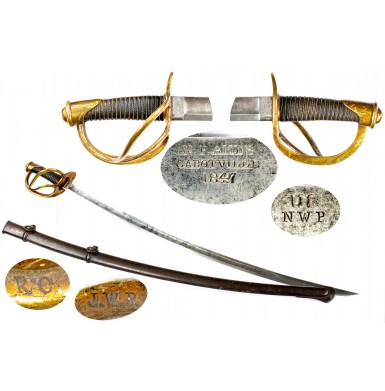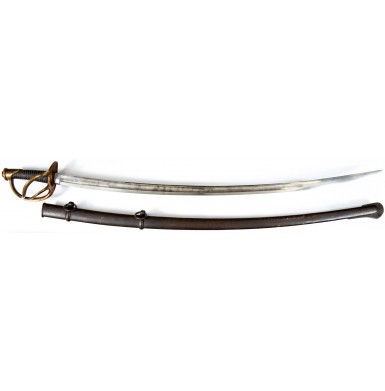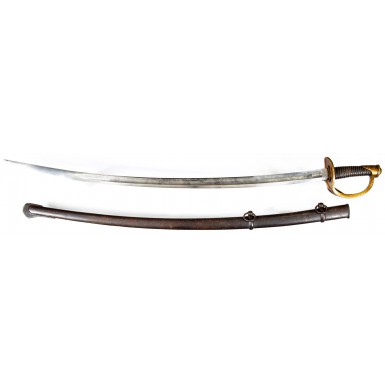Mexican War Dated Ames Model 1840 Heavy Cavalry Saber
- Product Code: EWSK-1609-SOLD
- Availability: Out Of Stock
-
$1.00
In 1838, Colonel George Bomford sent a letter to Secretary of War Joel Roberts Poinsett, stating that the current issue US Model 1833 Dragoon Saber was “unsatisfactory” and suggested a survey of the sabers then in use by the various European powers to find a new pattern to adopt. It is interesting to note that while Poinsett is at best a footnote in history as a Secretary of War, he is well known to this by the name given to a flowering plant that he introduced to the United States after serving as the first United States Minister to Mexico; the poinsettia.
In 1832, the US military had established the first permanent mounted arm to the standing army since the War of 1812. While cavalry, dragoons and other mounted troops had served the United States during the previous two decades, they had all been state troops and were not part of the full-time professional army of the United States. The first permanent establishment of US mounted after the American Revolution has been a squadron of light dragoons that was authorized in 1792 which had grown to eight squadrons in 1798, which were designated as the Regiment of Light Dragoons. The regiment was deauthorized in 1800 and fully disbanded in 1802. In April of 1808, another standing regiment of light dragoons was established, with a second regiment authorized in January of 1812, in anticipation of the coming conflict with Great Britain. During the War of 1812 additional battalions of volunteer cavalry were raised to supplement the regular mounted service. With the conclusion of the war, both the volunteer and regular army dragoons were disbanded, and mounted US troops would not be part of the standing US Army again for nearly two decades.
In 1832, the westward press of US expansion lead to the establishment of a Battalion of Mounted Rangers to provide protection to settlers and immigrants moving west, particularly along the Santa Fe Trail. This force was subsequently reorganized as the United States Regiment of Dragoons in 1833. Like all pervious US Dragoon forces, the men were really used as mounted infantry who were expected to travel quickly via horseback and then fight dismounted upon their arrival on the scene. The dragoons were armed with a variety of weapons and were issued the first new official US pattern mounted saber since the War of 1812 period. This was the US Model 1833 Dragoon Saber, a design copied from the English Pattern 1821 Light Cavalry Saber. The new design was produced by the Ames Sword Company and ended the reliance upon the Starr contract Model 1812 Saber for mounted troops. In 1836, a second regiment of Dragoons was added to the US Army’s Order of Battle. The dragoons served on multiple fronts during the 1830s, primarily fighting Native Americans either during the Seminole Wars in Florida or on the western frontier. In 1846, immediately prior to the beginning of the Mexican American War a third mounted regiment would be added, this time the US Mounted Rifles. It would not be until August of 1861 that an official “Cavalry” branch of service would be added to the US Regular Army. At that time, two additional regiments of mounted troops were raised and designated as “cavalry” and the three earlier regiments were re-designated as “cavalry”, with the five regiments designates as the 1st through 5th US Cavalry.
By 1838, the shortcomings of the M1833 Dragoon Saber were becoming apparent. The saber was apparently too light for field service and the evolution of the Dragoons into more of a Light Cavalry type organization suggested that the adoption of a more traditional European “light cavalry” pattern saber was appropriate. During the 19th century the European system of cavalry broadly differentiated between the “Heavy Cavalry” which typically charged formations of infantry to break them. These men were typically armed with lances and long, heavy, straight-bladed sabers. The “Light Cavalry” were utilized as scouts, screens and flankers for infantry movements, and would pursue retreating troop formations broken by the infantry or heavy cavalry charges. The saber for the light cavalry was traditionally a curved blade design intended for cutting and slashing, rather than stabbing.
After considering the potential European patterns available, in 1839 the US Ordnance Department ordered 500 light cavalry sabers from England, 600 light cavalry sabers from Prussia and 500 light cavalry sabers from France, along with 100 light artillery sabers from the French as well, for field trials. After analyzing the various patterns, the US Ordnance Department review board that was chaired by Lt. Colonel George Talcott chose the French Model 1822 Light Cavalry Saber for adoption by the Dragoons and the French pattern light artillery saber for use by the mounted (light or field) artillery. Due to the less than positive experience the Ordnance Department had had with the Ames produced M1833 sabers, the first orders for what would become the US Model 1840 Heavy Cavalry Saber were placed with Prussian cutler Schnitzler & Kirschbaum (S&K). A total of 2,000 enlisted sabers and 1 officer’s sabers (with the blade etched to R.L. Baker) were part of the 1840 contract. The contract also included 500 US M1840 Light Artillery Sabers, 50 Officer’s Light Artillery Sabers and four additional artillery officer’s sabers, which were etched to R.L. Baker, G. Talcott, A. Mordecai and B. Huger.
The new saber design had a nominally 36” long, single-edged blade with a wide, stopped fuller. The grooved wood grip was covered in thin leather and wrapped with twisted brass wire. A cast brass three-branch guard, including the knuckle bow, protected the hand and the pommel cap was of the classic Phrygian helmet style. The nominal weight of the saber 2 pounds, 6 ounces (4 pounds, 8 ounces in the sheet iron scabbard) resulted in the nickname that these swords would be known by to this day, the “Old Wrist Breaker”. The US M1840 Cavalry Saber would be the standard mounted services saber until it was finally replaced by a lighter, slimmer version of the saber, designated as the Model 1860 Light Cavalry Saber. Despite this, most of the M1840 sabers in service at the outbreak of the Civil War remained in service throughout the war. The Model 1840 would see service as our standard cavalry saber from its adoption through the end of the Seminole War period, on the plains and western frontier during pre-Civil War expansion, in the Mexican American War and throughout the Civil War, giving the saber a service life of nearly three decades.
Despite the initial order for US Model 1840 Sabers being placed with S&K, by 1844 the Ordnance Department had returned to the Ames Manufacturing Company. In 1844, a contract was placed for 2,000 M1840 sabers from Ames, with deliveries beginning in 1845, when 600 were delivered. Between 1844 and 1858 a total of 21,700 US Model 1840 Sabers would be ordered from Ames in a total of nine contracts, and between 1845 and 1858 that number of sabers would be delivered.
Offered here is a wonderful example of an 1847 dated Ames Model 1840 Heavy Cavalry Saber. This saber was part of the second Ames contract, issued in 1846 for a total of 4,000 sabers. Only 1,000 of the 1846 contract sabers were delivered that year, with bulk of that contract, 2,720 sabers, being delivered in 1847. This saber was delivered in the middle of the Mexican American War, which commenced on April 25, 1846 and ended on February 3, 1848. While it is impossible to know for sure, the saber certainly has the potential of having seen service during that war, but likely with US volunteers rather than regular army troops and more likely with the norther US army group under Zachary Taylor than the southern invasion force under Winfield Scott. No doubt the saber saw additional service on the post-Mexican War western frontier and during the American Civil War.
The saber remains in about FINE condition and is 100% complete and correct in every way. The obverse ricasso is clearly marked in two lines: US / NWP and on the reverse ricasso N.P. AMES / CABBOTVILLE / 1847. The top of the pommel cap is marked with the inspector initials RC and J.W.R. The “NWP” inspection is the mark of long time civilian Ordnance Department inspector Nahum W. Patch, who inspected contract arms for nearly two decades from the early 1830s through the late 1840s. Patch spent much of 1845, 1846 and 1847 inspected swords at the Ames factory. The “RC” on the pommel cap is the mark of Springfield Arsenal sub-inspector Rufus Chandler who spent most of his career inspecting contract arms produced by Ames, although his mark is typically found on Ames manufactured firearms like Model 1842 Box Lock Navy Pistols and Jenks Breechloading Navy carbines. His mark is found on M1841 Naval Cutlasses and some M1847 Sappers & Miners Bayonets but is only noted occasionally on 1847 dated Ames M1840 Cavalry Sabers. The final set of initials on the pommel cap are the final acceptance mark of Major James Wolfe Ripley of the US Ordnance Department, who was also the superintendent of the Springfield Arsenal from 1842-1854. Ripley would spend his entire career in the US Army, rising from the rank of 2nd Lieutenant after his graduation from West Point in 1814 to brevet Major General in 1866. Ripely was the 5th officer to be the Chief of Ordnance of the US Army. The drag of the scabbard retains a weak sub-inspection mark that ends in a “K” and appears to have an “H” as the second letter. This suggests the scabbard was inspected by civilian sub-inspector Albert H. Kirkman. Other than the inspection on the scabbard drag, all of the markings remain clear, crisp and fully legible.
As noted, the saber is in about FINE condition. The blade remains full-length and measures 35 5/8” with a 7/8” wide, 26 ½” stopped fuller. A narrow, 18” long secondary fuller is also present near the spine of the blade. The blade has a slightly dull pewter patina over much of its surface with some traces of the arsenal polish, as well as some hints of cross polish near the ricasso. The blade shows some thinly scattered areas of light surface oxidation and discoloration, with some areas of brown and dark gray scattered on the blade here and there. There is some more moderate age discoloration present on the blade about 9” from the hilt and continuing for about 10” towards the tip. The edge of the blade is free of any nicks or chips but does show some very light traces of sharpening marks. These are very minor and are really nothing more than minor surface scuffs. The brass hilt has a rich, uncleaned, dark bronze patina and also shows some very old and discolored varnish or other clear protectant that was placed on the brass long ago. This could be cleaned if so desired, but the rich color and patina is quite attractive as it is. The peen of the tang at the pommel cap is perfect and completely undisturbed. The blade is solidly mounted in the hilt and both the blade and guard are free of any wiggle or wobble. The original buff leather throat washer is in place forward of the guard at the hilt to blade junction. The grip retains nearly all of the thin leather covering, which shows light to moderate wear and some thinning and minor leather loss here and there. The leather has a rich, dark brown color and remains tight and in solid shape. The original eighteen wraps of twisted brass wire are in place on the grip. The wire remains solid and completely intact but does show some minor areas of looseness here and there. The scabbard remains in about VERY GOOD condition. It is also solid and complete and retains its original throat and both iron suspension rings. The scabbard has a rich, untouched and heavily oxidized brown patina with scattered light to moderate surface oxidation and some areas of light pitting, particularly on the drag. The scabbard also shows some scattered patches of surface roughness here and there. The lap-seamed scabbard shows numerous small dings and minor impact marks, particularly along the lower edge, from about the middle of the scabbard to the drag. However, the scabbard is free of any significant dents and shows no bends or damage other than the typical marks from light to moderate use.
Overall this is a really attractive, well-marked and unmolested example of a desirable Mexican War marked Ames Model 1840 Heavy Cavalry Saber. The saber shows real world use and light to moderate wear with wonderful age but has escaped any serious damage or abuse during its service life that included at least two major conflicts. Only 2,720 of these sabers were delivered by Ames during the height of the Mexican American War in 1847 and few survive in such complete, untouched and undamaged condition. This would be a wonderful addition to any collection of Mexican War or Civil War period swords and would be particularly at home in a collection that focuses on the arms and equipment of the 1st or 2nd US Dragoons.
SOLD
Tags: Mexican, War, Dated, Ames, Model, 1840, Heavy, Cavalry, Saber












